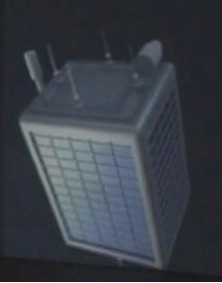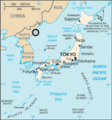Kwangmyŏngsŏng-2 facts for kids

Kwangmyongsong-2 as it would have looked in orbit in a 2009 computer graphic video
|
|
| Mission type | Communication/Technology |
|---|---|
| Operator | KCST |
| Mission duration | Failed to orbit |
| Start of mission | |
| Launch date | April 5, 2009, 02:20:00 UTC |
| Rocket | Unha-2 |
| Launch site | Tonghae |
| Orbital parameters | |
| Reference system | Geocentric |
| Regime | Low Earth |
| Perigee | 490 kilometres (300 mi) |
| Apogee | 1,426 kilometres (886 mi) |
| Inclination | 40.6 degrees |
| Period | 104.2 minutes |
| Epoch | Claimed |
Kwangmyŏngsŏng-2 (which means Bright Star-2 or Lode Star-2) was a satellite launched by North Korea on April 5, 2009.
Before the launch, many countries, like the United States, South Korea, and Japan, were worried. They thought North Korea might be testing technology for a long-range missile. This type of missile is called an intercontinental ballistic missile. It can travel very far, even across continents.
The United States and the European Union strongly criticized the launch. Meanwhile, China and Russia asked everyone to stay calm.
On April 13, 2009, the United Nations Security Council said the launch broke a rule. This rule was from a past agreement called United Nations Security Council Resolution 1718. The very next day, North Korea said this statement was unfair. They said it went against their right to explore space, which is part of the Outer Space Treaty. Because of this, North Korea stopped taking part in the Six Party Talks. These talks were about trying to solve problems peacefully.
Contents
What does the name Kwangmyŏngsŏng mean?
The name "Kwangmyŏngsŏng" is very important in North Korea. It is linked to their national pride and the special way they view their leaders.
North Korean stories say that when their former leader, Kim Jong-il, was born, a bright star appeared in the sky. This star was called "kwangmyŏngsŏng," or "lode star." A lode star is a guiding star. This story made people believe a new great leader had arrived. Even though Kim Jong-il was born in Russia, North Korea says he was born on Paektu Mountain.
Getting ready for the launch
The launch was first announced on February 24, 2009. The Korean Central News Agency (KCNA) reported it. They said the Korean Committee of Space Technology was getting ready to launch a satellite. The launch would happen from Musudan-ri in Hwadae.
Around the same time, Kim Jong-il visited the area where the launch site is. He had done this before their last launch in 2006. On February 26, 2009, KCNA also said that North Korea planned to launch many different types of satellites in the future.
Telling the world about the launch
On March 12, North Korea announced they had signed two important agreements. These were the Outer Space Treaty and the Registration Convention. They also told the ICAO and IMO about their plans.
They said they would launch a satellite between April 4 and 8. The launch window, or specific time, would be from 02:00 to 07:00 UTC. They also shared where parts of the rocket were expected to fall. The first part was planned to fall about 650 kilometres (400 mi) east of South Korea's Donghae. The second part would fall about 3,600 kilometres (2,200 mi) further away. The third part, with the satellite, would try to reach low Earth orbit. North Korea warned that the waters near Japan's Akita and Iwate were risk zones for falling debris.
The launch day
On April 4, 2009, the Japanese government mistakenly announced that the rocket had been fired. They sent out emergency warnings across the country. But less than five minutes later, they took back the announcement. They said it was a mistake from their radar system.
On April 5, 2009, North Korea announced that Kwangmyŏngsŏng-2 had been officially launched. However, officials in South Korea, Russia, and the United States reported something different. They said the rocket and its payload (the satellite) had fallen into the Pacific Ocean. This meant it had not reached orbit.
In August 2009, special postage stamps were made to remember the launch. The stamps said, "Launch of Artificial Satellite 'Kwangmyongsong No. 2' in the DPRK."
Images for kids
-
The circle locates North Korea's Tonghae Satellite Launching Ground (Musudan-ri)
See also
 In Spanish: Kwangmyŏngsŏng-2 para niños
In Spanish: Kwangmyŏngsŏng-2 para niños



